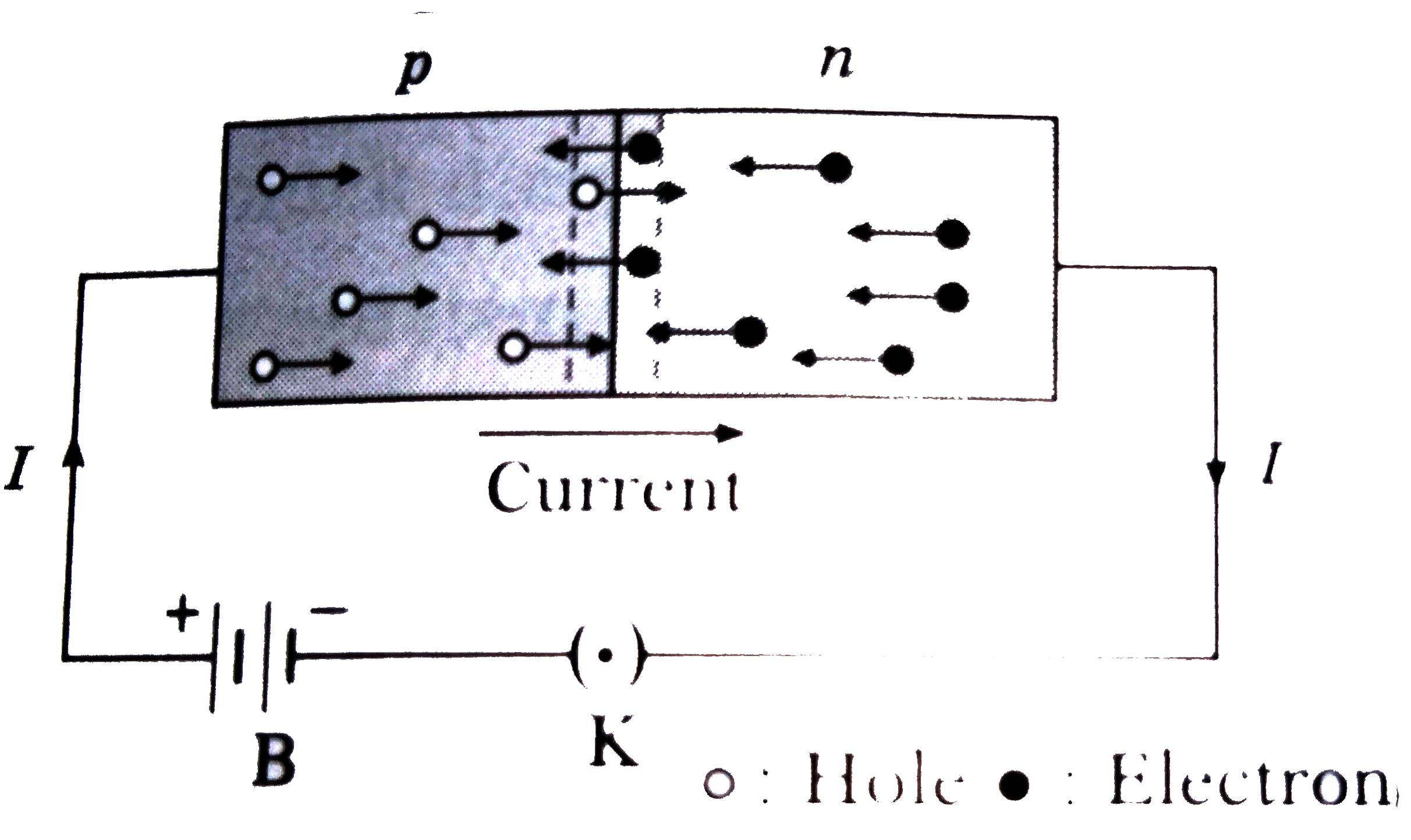Explain the working of a pn-junction diode in forward- and reverse-biased modes.
Text Solution
Forward-biased mode: A pn junction diode is said to be forward-biased when the positive terminal of a battery is connected to the p side of the junction and the negative terminal to the n side
In this case, the depletion the potential barrier is lowered.
Then the diode has a very low resistance.

The electrons travel from then side to the p side and go to the positive rminal of the battery. The holes that travel fron the p side to the n side combine with the electrons injected into the n-region from the negative terminal of the battery. This way, the diode conducts when forward biased and acts as a closed switch. The total current across the junction is called the forward current and is due to motion of both electrons and holes.
Reverse-biased mode : A pn-junction diode is said to be reverse biased when the positive terminal of the battery is connected to the n side of the junction, and the negative terminal to the p side.

In this case, the depletion region widens and the potential barrier is increased so that the diode has a high resistance.
The holes in the pregion combine with the electrons injected into the pregion from the negative terminal of the battery.The way, the majority charge carrier concentration in each region decreases from the equilibrium concentration and the diffusion current across the jinction becomes zero. thus, the diode does not conduct when reverse biased and is said to be in a non-conducting state i.e., it acts as an open switch (almost).
However , there is a very small current due to the motion of minority charge carries. The potential barrier sids the flow of minority change carriers, electrons in the p-region and holes in the n-region, to cross junction in opposite directions. This current is called the reverse current.
|
Topper's Solved these Questions
- EXPLANATION, CHARACTERISTICS AND PROPERTIES Book:NAVNEET PUBLICATION - MAHARASHTRA BOARDChapter:EXPLANATION, CHARACTERISTICS AND PROPERTIES Exercise:Communication Systems
Explore 7 Videos
- EXPLANATION, CHARACTERISTICS AND PROPERTIES Book:NAVNEET PUBLICATION - MAHARASHTRA BOARDChapter:EXPLANATION, CHARACTERISTICS AND PROPERTIES Exercise:Assignments
Explore 2 Videos
- EXPLANATION, CHARACTERISTICS AND PROPERTIES Book:NAVNEET PUBLICATION - MAHARASHTRA BOARDChapter:EXPLANATION, CHARACTERISTICS AND PROPERTIES Exercise:Atoms, Molecules and Nuclei
Explore 6 Videos
- EXPERIMENTS AND DIAGRAMSBook:NAVNEET PUBLICATION - MAHARASHTRA BOARDChapter:EXPERIMENTS AND DIAGRAMSExercise:ATOMS, MOLECULES AND NUCLEI
Explore 1 Video
- INSTRUMENTS : CONSTRUCTION AND WORKING Book:NAVNEET PUBLICATION - MAHARASHTRA BOARDChapter:INSTRUMENTS : CONSTRUCTION AND WORKING Exercise:Semiconductors
Explore 6 Videos
Similar Questions
Knowledge Check
For making p-n junction diode forward biased:
Asame potential is appliedBgreater potential is given to n compared to pCgreater potential is given to p compared to nDunbalanced concentrationWhen p−n junction diode is forward biased then
Athe depletion region is reduced and barrier height is increasedBthe depletion region is widened and barrier height is reducedCboth the depletion region and barrier height are reducedDboth the depletion region and barrier height are increasedWhen p−n junction diode is forward biased then
Athe depletion region is reduced and barrier height is increased.Bthe depletion region is widened and barrier height is reduced.Cboth the depletion region and barrier height are reduced.Dboth the depletion region and barrier height are increased.
When p−n junction diode is forward biased then
View SolutionWhen p−n junction diode is forward biased then
View SolutionIn the following diagram, is the junction diode forward biased or reverse biased ?

View SolutionOn adjusting the P−N junction diode in forward biased
View SolutionWhen p−n junction diode is forward biased then
View Solution

